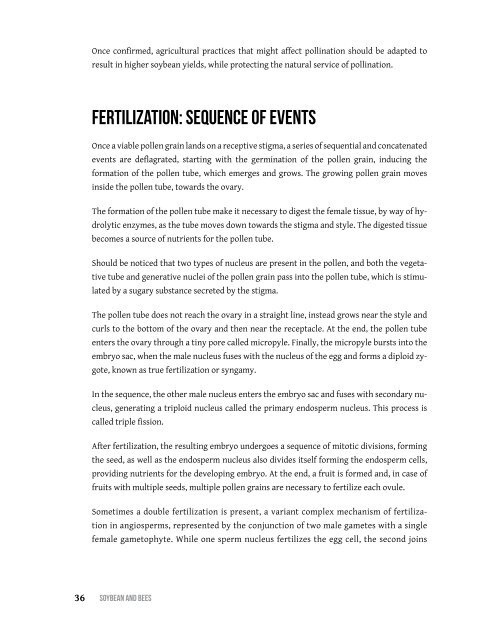Soybean and Bees
Create successful ePaper yourself
Turn your PDF publications into a flip-book with our unique Google optimized e-Paper software.
Once confirmed, agricultural practices that might affect pollination should be adapted to<br />
result in higher soybean yields, while protecting the natural service of pollination.<br />
Fertilization: sequence of events<br />
Once a viable pollen grain l<strong>and</strong>s on a receptive stigma, a series of sequential <strong>and</strong> concatenated<br />
events are deflagrated, starting with the germination of the pollen grain, inducing the<br />
formation of the pollen tube, which emerges <strong>and</strong> grows. The growing pollen grain moves<br />
inside the pollen tube, towards the ovary.<br />
The formation of the pollen tube make it necessary to digest the female tissue, by way of hydrolytic<br />
enzymes, as the tube moves down towards the stigma <strong>and</strong> style. The digested tissue<br />
becomes a source of nutrients for the pollen tube.<br />
Should be noticed that two types of nucleus are present in the pollen, <strong>and</strong> both the vegetative<br />
tube <strong>and</strong> generative nuclei of the pollen grain pass into the pollen tube, which is stimulated<br />
by a sugary substance secreted by the stigma.<br />
The pollen tube does not reach the ovary in a straight line, instead grows near the style <strong>and</strong><br />
curls to the bottom of the ovary <strong>and</strong> then near the receptacle. At the end, the pollen tube<br />
enters the ovary through a tiny pore called micropyle. Finally, the micropyle bursts into the<br />
embryo sac, when the male nucleus fuses with the nucleus of the egg <strong>and</strong> forms a diploid zygote,<br />
known as true fertilization or syngamy.<br />
In the sequence, the other male nucleus enters the embryo sac <strong>and</strong> fuses with secondary nucleus,<br />
generating a triploid nucleus called the primary endosperm nucleus. This process is<br />
called triple fission.<br />
After fertilization, the resulting embryo undergoes a sequence of mitotic divisions, forming<br />
the seed, as well as the endosperm nucleus also divides itself forming the endosperm cells,<br />
providing nutrients for the developing embryo. At the end, a fruit is formed <strong>and</strong>, in case of<br />
fruits with multiple seeds, multiple pollen grains are necessary to fertilize each ovule.<br />
Sometimes a double fertilization is present, a variant complex mechanism of fertilization<br />
in angiosperms, represented by the conjunction of two male gametes with a single<br />
female gametophyte. While one sperm nucleus fertilizes the egg cell, the second joins<br />
36 SoybeAn <strong>and</strong> bees


